INTRODUCTION
The use of morphometric analyses to discriminate between genetically discrete groups within a fish species is limited by the difficulty of identifying environmentally induced variations in body shape (Ihssen et al., 1981; Currens et al., 1989; Park et al., 2001). Both the truss and classical dimensions are used to describe the fish body shape (Hubbs & Lagler, 1947; Sträuss & Bookstein, 1982). The truss dimensions consist of a systematically arranged set of distances that are measured between a set of preselected anatomical landmarks (Sträuss & Bond, 1990). These landmarks are identified based on local morphological features and are chosen to divide the body into functional units (Sträuss & Bond, 1990). The truss dimensions, which include the components of body depth and length along the longitudinal axis, have theoretical advantages over the classical morphometric characteristics in the discrimination of groups (Park et al., 2007).
The Ussurian bullhead, Leiocassis ussuriensis, belongs to the family Bagridae and is found in several Korean rivers (the Daedong River, Amnok River, Imjin River, Han River, and Geum River, and recently in the Nakdong River) (Kim et al., 1997). It is a nocturnal fish, living in slow-moving rivers with bottoms of mud or sand. Its chewy flesh has an excellent taste of umami, and together with the Korean bullhead, Pseudobagrus fulvidraco, it is an essential ingredient of the spicy freshwater fish stew of Korea (Lim et al., 2012).
The Korean bullhead belongs to the Siluriformes, in the family Bagridae (Park & Lee, 1996). It occurs throughout Asia, and is commonly found in the West Sea and South Sea, as well as the midstream and downstream reaches of rivers in Korea (Park & Lee, 1996; Kim & Park, 2002). The Korean bullhead body lacks scales and the head is flat. It is a predominantly carnivorous fish that feeds preferentially at night (Lee, 1993). In common with Ussurian bullhead, it is highly valued for its taste and together with the catfish or carp, is the main component of a spicy freshwater fish stew. Consequently, the demand for the Korean bullhead is increasing (Lee, 1993).
Yolk absorption and early growth have been investigated extensively in the rainbow trout, Oncorhynchus mykiss, and the chum salmon, O. keta, and eye development has been studied in the dark-banded rockfish, Sebastes inermis, and the dotted gizzard shad, Konosirus punctatus (Zhang et al., 1995; Park et al., 1996; Park et al., 2006; Park et al., 2012). However, there have been few similar studies of the Ussurian bullhead or Korean bullhead, two species with similar spawning seasons and habitats.
In this study, we investigated and compared the process of yolk absorption in these two species and examined the changes in their morphometric characteristics during their early development. Our results should provide important data for basic research into yolk absorption and the external and internal changes that occur in larval fish.
MATERIALS AND METHODS
We examined juvenile specimens of the Ussurian bullhead, L. ussuriensis (n = 30), and the Korean bullhead, P. fulvidraco (n = 30). On June 28, 2012, we obtained fertilized eggs of both species from the Southern Island Fishery Research Institute of the National Fisheries Research and Development Institute of Korea. The larvae were reared and bred at the Fisheries Genetics and Breeding Sciences Laboratory, Korea Maritime University, Busan, Korea, in 10 tanks (100ℓ) that included a circulation pump, an aeration system, and a temperature control system. Dissolved oxygen levels were maintained with an air pump, and the water temperature was maintained at 26 ± 0.5°C.
Using digital Vernier calipers (CD-20CP, Mitutoyo, Japan) and an electric balance (JW-1, Korea); the morphometric dimensions and body weights were measured in units of 0.1 mm and 0.01 g, respectively. To measure the eye diameter (ED), yolk length (YL), yolk height (YH), and yolk volume (YV), we fixed 50 larvae each of the Ussurian bullhead and the Korean bullhead in 10% neutral formalin every day from one day post-hatching (1 DPH) to 9 DPH. We also measured the larvae of both species in the yolk stage using the same method. We measured standard length (Ls), YL, YH, and ED according to DPH. Volume = π/6 × a × b2, where a is yolk length and b is yolk height (Park et al., 1996).
Ussurian bullhead (n = 50) and Korean bullhead larvae (n = 50) were randomly selected every 10 DPH from 10 DPH to 150 DPH and 130 DPH, respectively, and fixed in 10% neutral formalin. Body outline measurements were made for 25 distances between landmarks for both truss and classical dimensions (Table 1, Fig. 1). We measured the Ussurian bullhead and Korean bullhead to the nearest 1 mm using a Vernier calipers (CD-20CP; Japan). Their weights were measured with an electronic scale according to DPH.
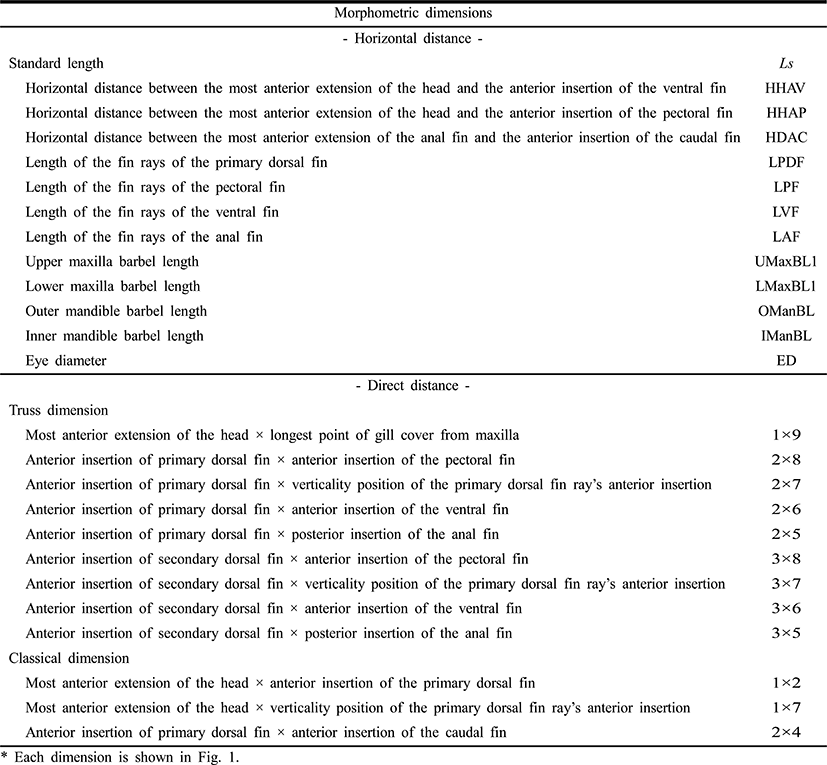
|
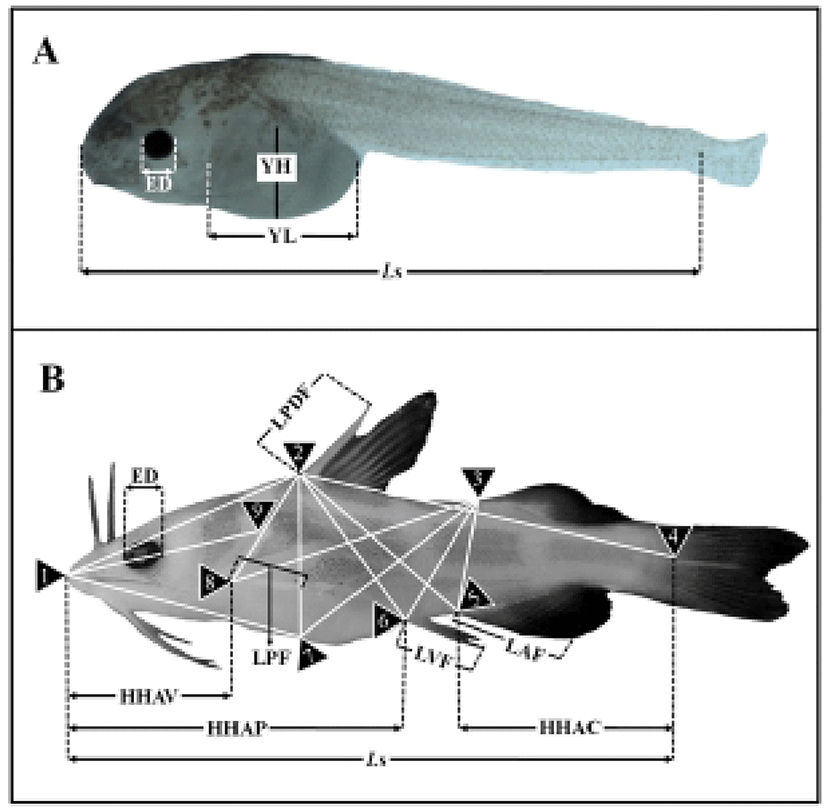
The following horizontal distances were measured: Ls, the horizontal distance between the anteriormost head and the anterior insertion of the ventral fin (HHAV), the horizontal distance between the anteriormost extension of the head and the anterior insertion of the pectoral fin (HHAP), the horizontal distance between the anteriormost extension of the anal fin and the anterior insertion of the caudal fin (HDAC), the length of the fin rays of the primary dorsal fin (LPDF), the length of the fin rays of the pectoral fin (LPF), the length of the fin rays of the ventral fin (LVF), the length of the fin rays of the anal fin (LAF), the upper maxilla barbel length (UMaxBL), the lower maxilla barbel length (LMaxBL), the outer mandible barbel length (OManBL), the inner mandible barbel length (IManBL), and ED. Other distances (truss morphometric dimensions and classical morphometric dimensions) were direct distance measurements.
The external truss morphometric dimensions measured were as follows: 1 × 9, the anteriormost extension of the head × the longest point of the gill cover from the maxilla; 2 × 8, the anterior insertion of the primary dorsal fin × the anterior insertion of the pectoral fin; 2 × 7, the anterior insertion of the primary dorsal fin × the vertical position of the anterior insertion of the primary dorsal fin ray; 2 × 6, the anterior insertion of the primary dorsal fin × the anterior insertion of the ventral fin; 2 × 5, the anterior insertion of the primary dorsal fin × the posterior insertion of the anal fin; 3 × 8, the anterior insertion of the secondary dorsal fin × the anterior insertion of the pectoral fin; 3 × 7, the anterior insertion of the secondary dorsal fin × the vertical position of the anterior insertion of the primary dorsal fin ray; 3 × 6, the anterior insertion of the secondary dorsal fin × the anterior insertion of the ventral fin; and 3 × 5, the anterior insertion of the secondary dorsal fin × the posterior insertion of the anal fin (Fig. 1B). Each external morphometric dimension was analyzed relative to Ls.
The external classical morphometric dimensions measured were as follows: 1 × 2, the anteriormost extension of the head × the anterior insertion of the primary dorsal fin; 1 × 7, the anteriormost extension of the head × the vertical position of the anterior insertion of the primary dorsal fin ray; and 2 × 4, the anterior insertion of the primary dorsal fin × the anterior insertion of the caudal fin (Fig. 1B). Each external morphometric dimensions was analyzed relative to Ls.
We sampled the larvae every five days from 1 DPH to 10 DPH, and thereafter at 10 day intervals. Ls and the body weight of each larva were measured, and their relationship analyzed. The values given are morphometric dimensions/Ls.
The study was performed in triplicate and the results are reported as means ± SD (n = 30), unless otherwise stated. The data were analyzed with one-way analysis of variance (ANOVA) using the SPSS statistical package (SPSS 9.0, SPSS Inc., Chicago, IL, USA). The means were compared with Duncan’s multiple range test and were considered significantly different at p<0.05.
RESULTS
Table 2 lists four morphometric dimensions/Ls for the Ussurian bullhead, L. ussuriensis, and the Korean bullhead, P. fulvidraco, from 1 DPH to 9 DPH. In the Ussurian bullhead, ED was 19.4 at 1 DPH. Thereafter, the eye/Ls ratio decreased to 6.6 at 9 DPH (p<0.05). YL also decreased from 31 to 6.4 by 9 DPH and this rate of decrease was greater than for any other dimension (p<0.05). YH decreased gradually from 4.7 to 2.1 by 9 DPH (p<0.05). From 1 DPH to 9 DPH, YL was always greater than YH (p<0.05). In the Korean bullhead up to 9 DPH, the values for ED, YL, and YH decreased from 18.4 to 6.8, from 30.4 to 6.5, and from 4.5 to 2.3, respectively (p<0.05). Of these measures, YL showed the greatest rate of decrease and YH the lowest rate (p<0.05). YL was always greater than YH (p<0.05). Both species showed similar trends in their early morphometric dimensions.
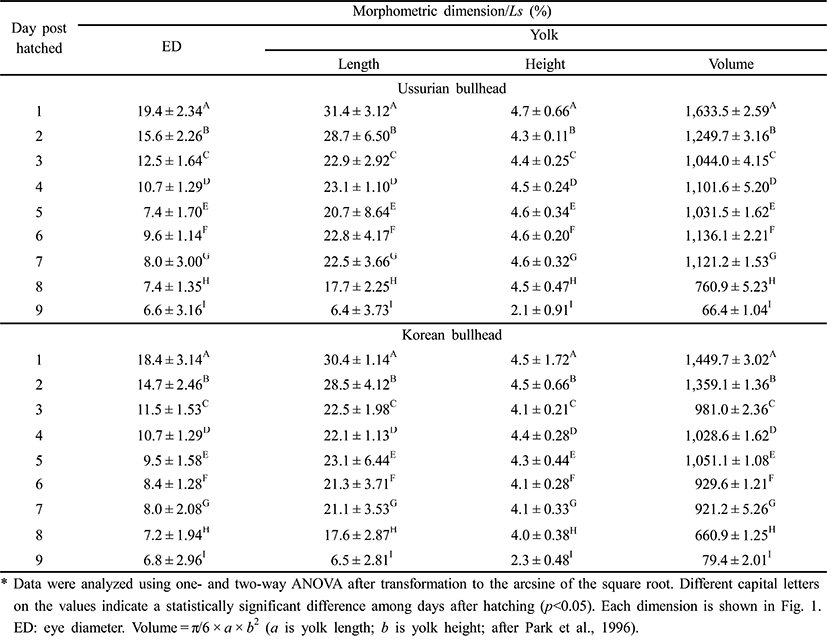
|
Fig. 2 shows the growth curves for the Ussurian bullhead. The increase in Ls was y = 5.0x–3.56, R2 = 0.9675 (y is standard length in mm, x is DPH), and the increase in bodyweight was y = 60.5x–65.44, R2 = 0.9939 (y is body weight in mg, x is DPH). The increases in Ls and bodyweight showed a positive relationship. Ls increased by 33.6 mm from 10 DPH to 40 DPH. Thereafter, the Ussurian bullhead ultimately grew to 81.9 mm (Fig. 2). The bodyweight of the Ussurian bullhead had increased to 1,014.2 mg at a steady rate by 150 DPH (Fig. 2). The rate of increase in bodyweight was more regular than the increase in Ls (Fig. 2). Bodyweight/Ls was y = 11.6x–7.17, R2 = 0.965 (y is bodyweight in mg, x is Ls in mm) (Fig. 3A). Bodyweight and Ls increased proportionally (Fig. 3A). Although the average bodyweight/Ls was 11, when Ls was 20–37 mm, bodyweight/Ls was 5.6, which indicates a slower increase in bodyweight than in Ls (Fig. 3A).
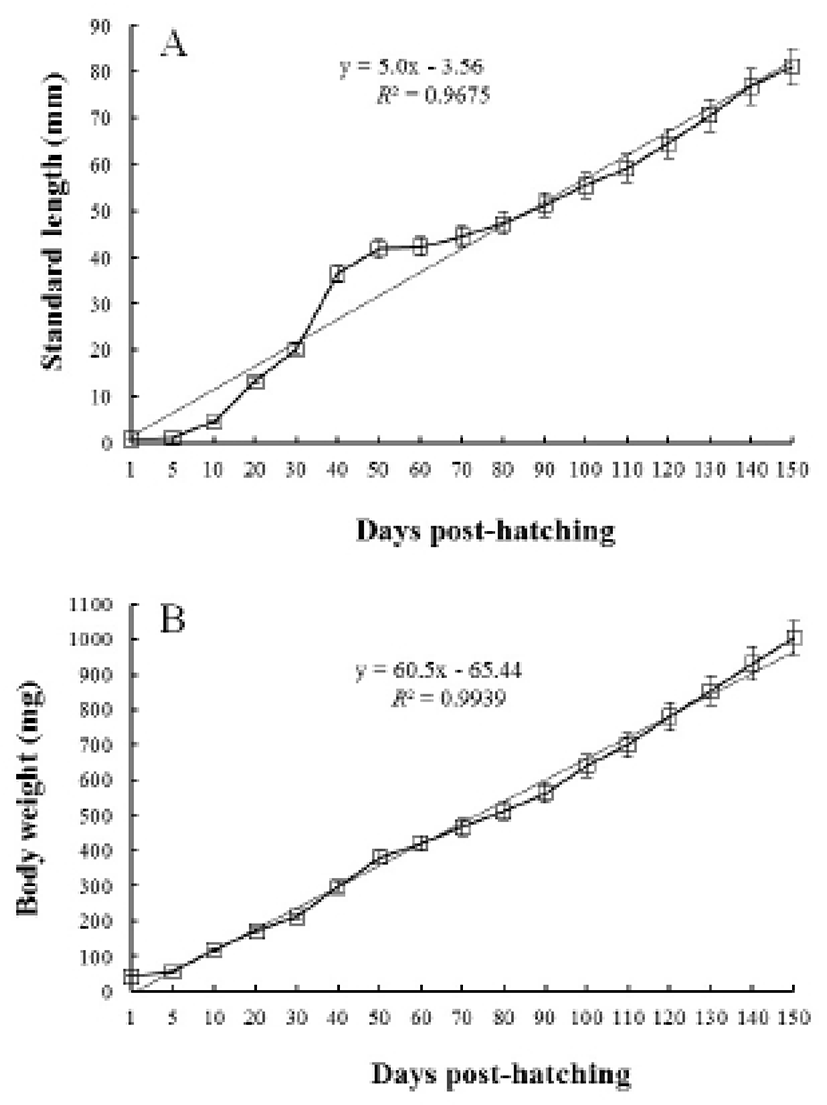
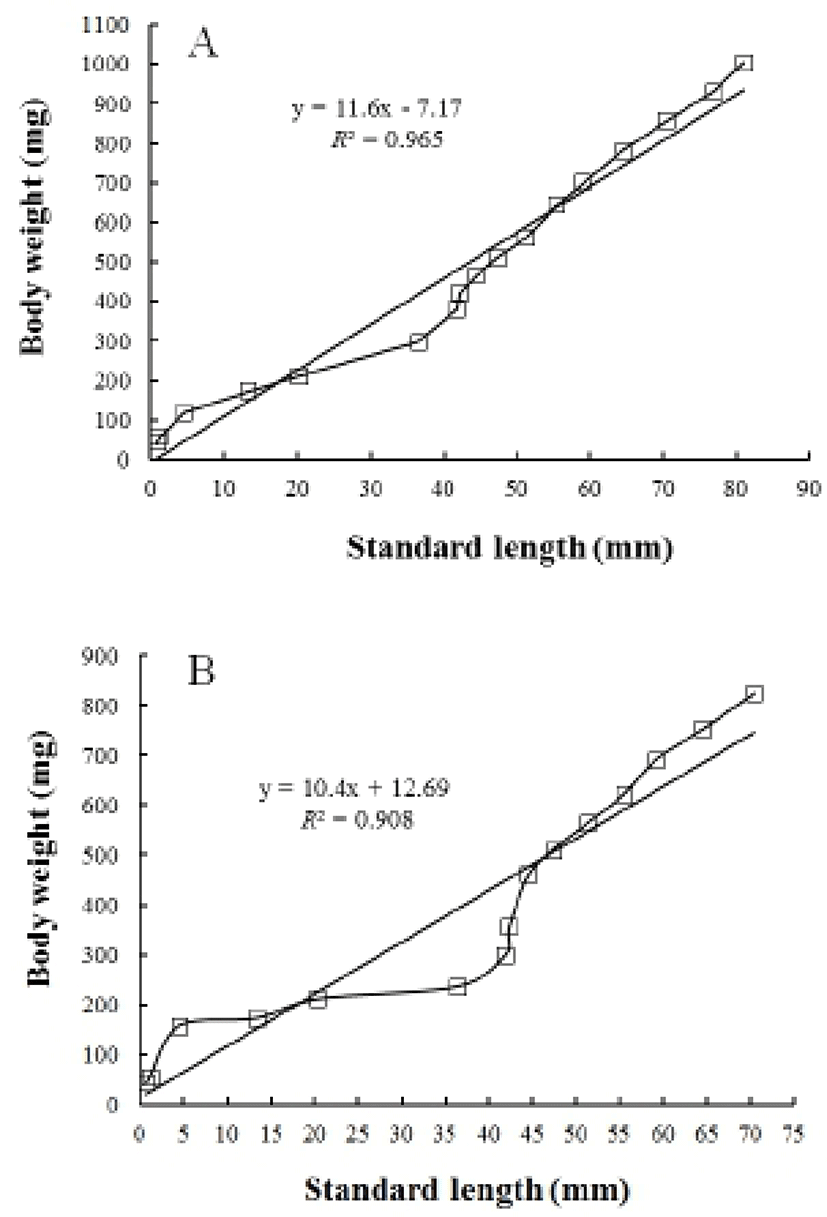
Fig. 4 shows the growth curves for the Korean bullhead. The increase in Ls was y = 5.0x–3.84, R2 = 0.9545 (y is Ls in mm, x is DPH), and the increase in bodyweight was y = 56.678x–56.152, R2 = 0.988 (y is bodyweight in mg, x is DPH). The increases in Ls and bodyweight showed a positive relationship. Ls increased to 36.7 mm from 30 DPH to 40 DPH. Thereafter, the Korean bullhead ultimately grew to 71.5 mm (Fig. 4). The bodyweight of the Korean bullhead increased rapidly to 161.3 mg from 5 DPH to 10 DPH, and to 463.1 mg from 60 DPH to 70 DPH (Fig. 4). By 130 DPH, the bodyweight of the Korean bullhead had increased at a steady rate to 835.4 mg (Fig. 4). Body weight/Ls was y = 10.4x + 12.69, R2 = 0.908 (y is bodyweight in mg, x is Ls in mm) (Fig. 3B). Bodyweight and Ls increased proportionally (Fig. 3B). Although the average bodyweight/Ls was 10, when Ls was 1–5 mm, bodyweight/Ls was 25, and when Ls was 43–45 mm, bodyweight/Ls was 50, which shows a faster increase in bodyweight than in Ls (Fig. 3B). However, when Ls was 4.7–37 mm, bodyweight/Ls was 2.5, which shows a slower increase of bodyweight than in Ls (Fig. 3B). Both species showed similar trends in their early growth.
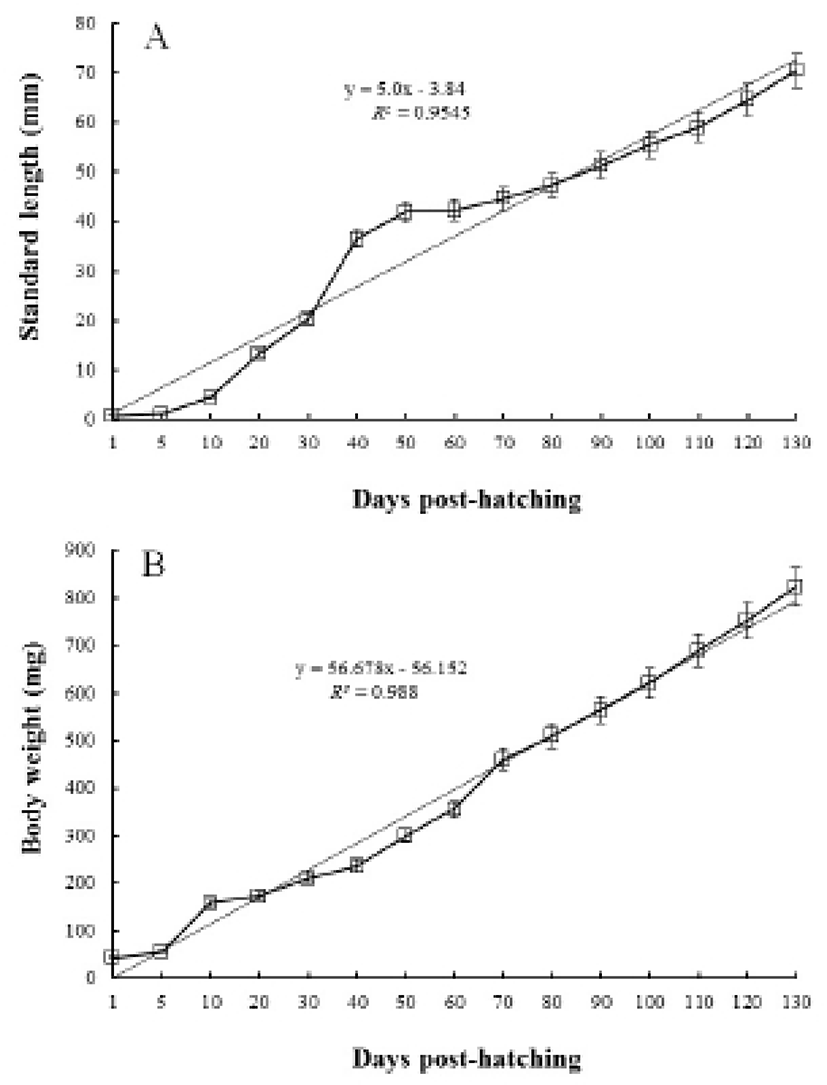
Table 3 lists 24 morphometric dimensions/Ls for the Ussurian bullhead, measured every 10 days from 10 DPH to 150 DPH. HHAP, HHAV, HDAC, 1 × 2, 1 × 9, 1 × 7, 2 × 8, 2 × 6, 3 × 8, LAF, and IManBL did not differ significantly at 20 DPH, and 2 × 5 did not differ significantly from 30 DPH to 150 DPH (p>0.05). Furthermore, 2 × 7 and 3 × 7 did not differ significantly by 150 DPH (p>0.05). During 150 DPH, 3 × 6 and LPF decreased gradually, whereas 3 × 5, 2 × 4, LPDF, LVF, UMaxBL, LMaxBL, OManBL, and ED gradually increased (p<0.05). The dimension 2 × 4 increased to 106.6%, LVF increased to 158.2%, and LMaxBL increased to 553.3%, and these dimensions showed the greatest growth rates in the external characteristics of the fish, in section of fin and in section of barbell, respectively (p<0.05).
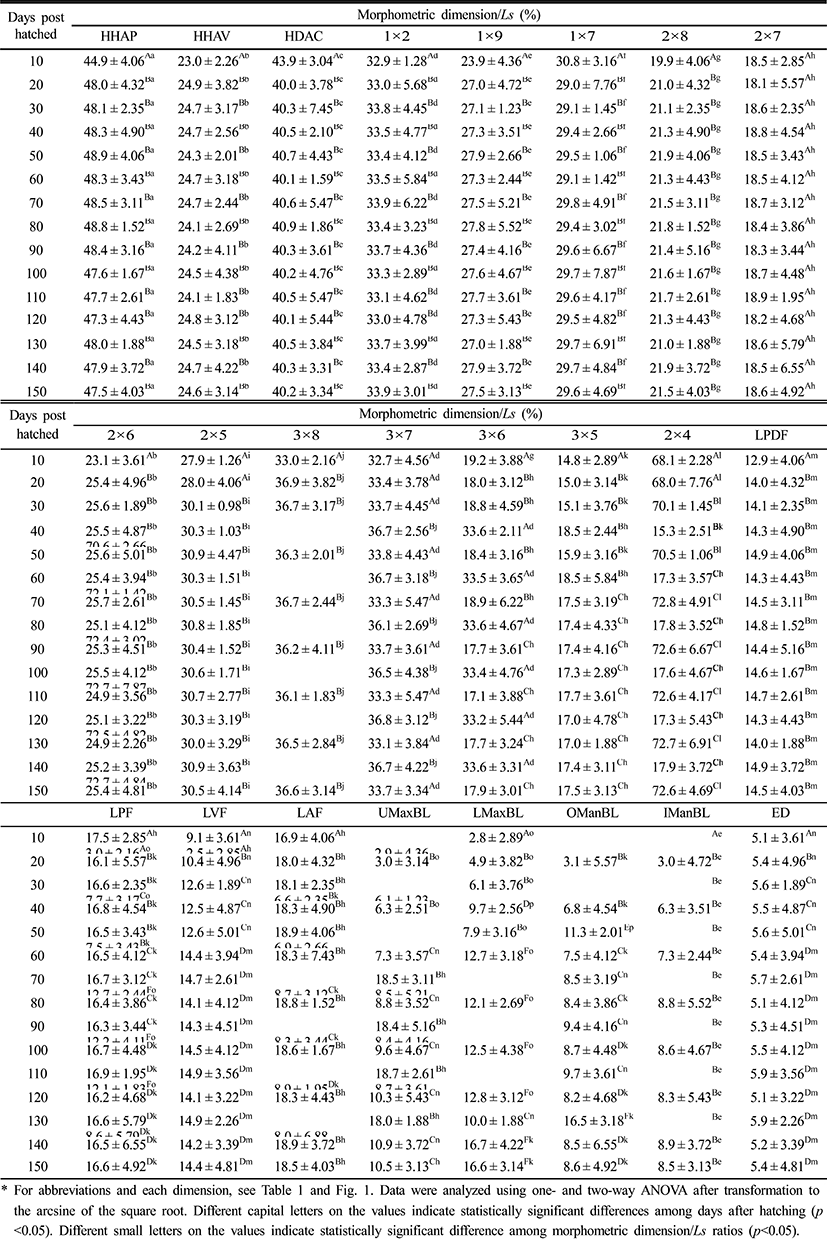
|
Table 4 lists 24 morphometric dimensions/Ls for the Korean bullhead measured every 10 days from 10 DPH to 130 DPH. HHAP, HHAV, HDAC, 1 × 2, 1 × 9, 1 × 7, 2 × 8, 2 × 6, 3 × 8, LPDF, and LAF did not differ significantly from 20 DPH to 130 DPH, and 2 × 5 did not differ significantly from 30 DPH to 130 DPH (p>0.05). During 130 DPH, 3 × 6 and LPF decreased gradually, whereas 3 × 5, 2 × 4, LVF, UMaxBL, LMaxBL, OManBL, IManBL, and ED gradually increased (p<0.05). The dimension 2 × 4 increased to 105.4%, LVF increased to 138.4%, and LMaxBL increased to 564.5%, and these showed the greatest growth rates in the external characteristics of the fish, in section of fin and in section of barbell respectively (p<0.05). Among these increases, the growth rate of the barbel section was greatest (p<0.05). Both species in section of fin and in section of barbell generally had the largest value and of the morphometric dimensions 3 × 5 and 2 × 4 showed increasing trends.
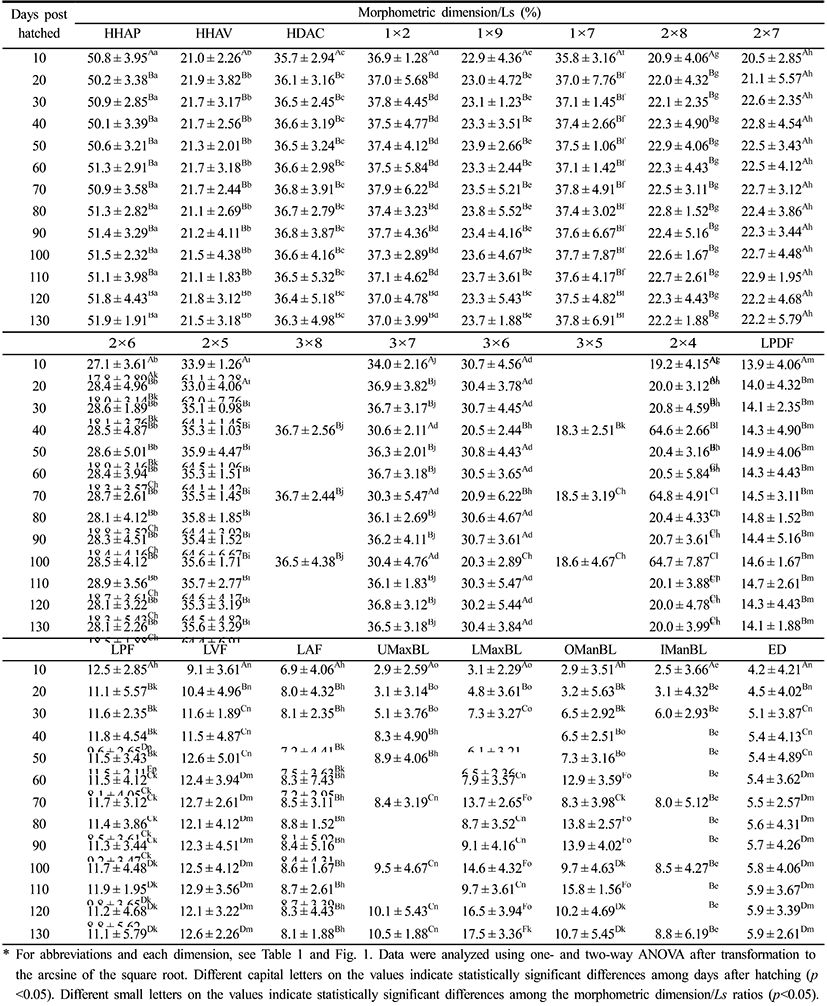
|
When we compared the morphometric dimensions/Ls, we found that HHAP, 1 × 7, 2 × 8, 2 × 7, 2 × 6, 2 × 5, and 3 × 5 of the Korean bullhead were higher than those of the Ussurian bullhead (p<0.05), and HHAV, HDAC, 1 × 2, 1 × 9, 3 × 7, 2 × 4, and LPF were lower in the Korean bullhead than in the Ussurian bullhead (p<0.05), whereas 3 × 8, LPDF, UMaxBL, LMaxBL, IManBL, and ED did not differ significantly between the two species (p>0.05). At 10 DPH, the increase in 3 × 8 was greater in the Korean bullhead (34.0 ± 2.16%) than in the Ussurian bullhead (33.0 ± 2.16%, p<0.05), but at 130 DPH, the increase in 3 × 8 was similar in the Korean bullhead (36.5 ± 3.18%) and the Ussurian bullhead (36.5 ± 2.84%, p>0.05). During the experimental period, 3 × 6 of the Korean bullhead increased from 19.2 ± 4.15% to 20.0 ± 3.99%, whereas that of the Ussurian bullhead decreased from 19.2 ± 3.88% to 17.4 ± 3.24%. At 10 DPH, LVF and OManBL did not differ significantly between the two species (p>0.05), but LVF and OManBL were higher in the Ussurian bullhead than in the Korean bullhead at 130 DPH (p<0.05). Thus, the increases in LVF and OManBL were faster in the Ussurian bullhead than in the Korean bullhead. In both species, LAF increased during the experimental period, but LAF was greater in the Ussurian bullhead than in the Korean bullhead (p<0.05). The relative sizes of the head region, pectoral fin, ventral fin, and anal fin were greater in the Ussurian bullhead than in the Korean bullhead (p<0.05), and the relative body depth and size of the outer mandible barbel were greater in the Korean bullhead than in the Ussurian bullhead (p<0.05).
As shown in Fig. 5A, the morphometric characteristics measured in this study were classified into three different patterns of increase. The dimensions 2 × 5, 3 × 5, and 2 × 4 are the main traits of each curve (Fig. 5A). When Ls was 42 mm, only the length of each dimension of the 2 × 5 series increased. At the same point, the length of each dimension of the 3 × 5 series deceased, and each dimension of the 2 × 4 series increased more rapidly than Ls (Fig. 5A). As shown in Fig. 5B, the morphometric characteristics measured in this study can also be classified into three different patterns of increase. HHAV, 2 × 5, and 3 × 5 are the main traits on each curve (Fig. 5B). When Ls was 42 mm, the the three curves showed a change in trend. The length of each dimension of the HHAV series decreased and the length of each dimension of the 2 × 5 and 3 × 5 series increased more rapidly than Ls (Fig. 5B).
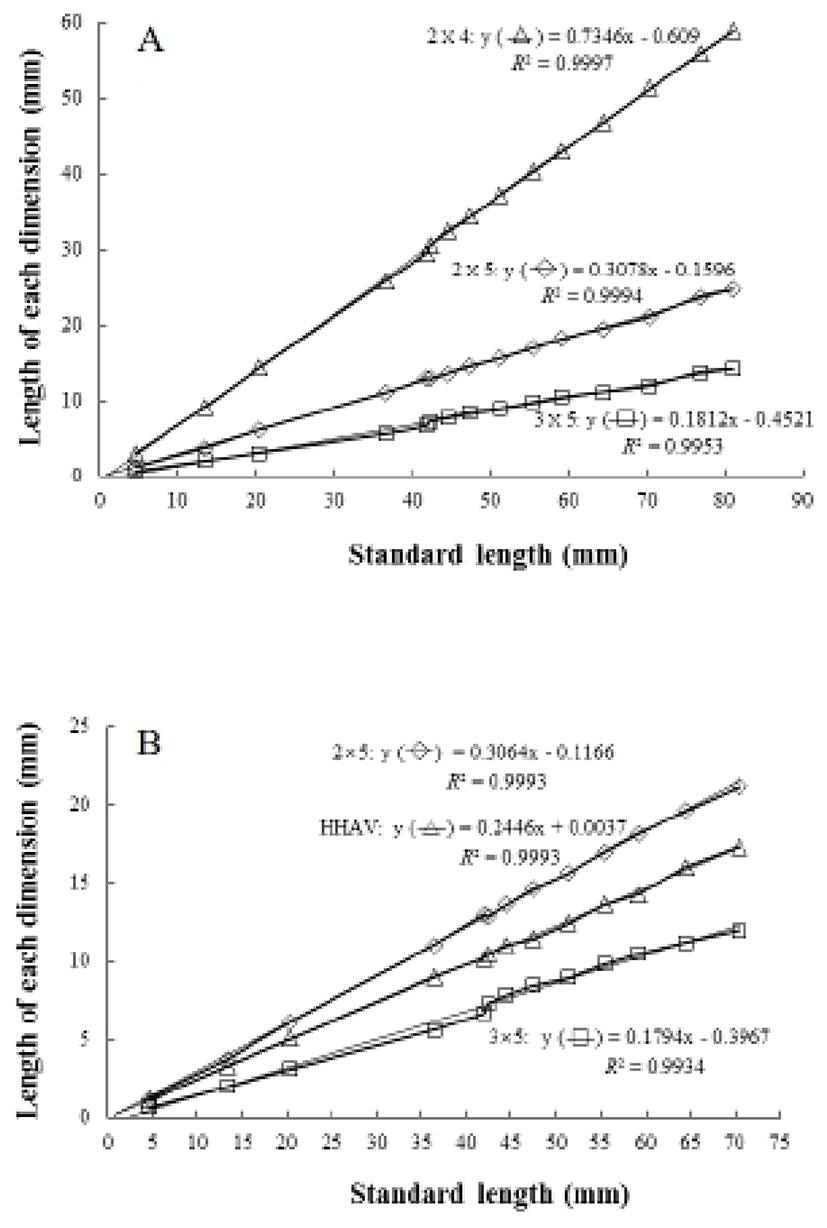
DISCUSSION
Although limited, research related to the early growth of the Ussurian bullhead and Korean bullhead has shown that when they hatch, both species have absorbed the whole yolk sac and begun to emerge (Dill, 1969, 1977; Brannon, 1972; Zhang et al., 1995). However, it is unclear how the yolk sac changes in shape from the start of its absorption. In this study, YL decreased with time. After hatching, YH also decreased, but the reduction was smaller than that in YL. Consistent with the reductions in YL and YH, YV also decreased, and the reduction in YV was greatest of the three dimensions. The rates of decline in these measures were similar in the Ussurian and Korean bullheads, but the decline in YV was greater in the Korean bullhead than in the Ussurian bullhead (Table 2). This decrease in YV means that, as in alevin, the juvenile reverts from endogenous feeding to exogenous feeding after the yolk sac declines (Dill, 1969, 1977; Brannon, 1972; Zhang et al., 1995).
The body length and bodyweight of the Ussurian and Korean bullheads increased gradually (Figs 2 and 4). The rate of increase in body length was similar in both species, but their growth rates in terms of bodyweight differed, increasing more in the Ussurian bullhead. The growth rate of body length was also the same in both fish species, whereas the growth rate of bodyweight differed between the species (Figs 2 and 4). Bodyweight/Ls increased more rapidly in the Ussurian bullhead than in the Korean bullhead (Fig. 3). This means that the rate of bodyweight increase in the Ussurian bullhead was greater than that in the Korean bullhead.
The truss dimensions are the primary units of classification and are based on the external anatomical markers normally assessed in fish (Sträuss & Bond, 1990). The truss dimensions are length measurements that refer to the ratio between the width of the fish’s body and the axis of the fish’s length. Theoretically, the truss dimensions are a better measure of the fish’s shape than the classical dimensions (Sträuss & Bookstein, 1982; Currens et al., 1989). Most of the morphometric traits of the Ussurian bullhead and Korean bullhead tended to increase during the study period (p<0.05;). The two fish species did not differ significantly in the 2 × 7 and 3 × 7 sections of body height; nor did HHAV, HHAA, or HDMC differ in the two species during the experimental period (p<0.05). After hatching, these shapes and ratios did not change significantly with time, and in the section of the barbel, the pectoral fin in both fish species decreased together, suggesting that the pectoral fin showed little growth as bodyweight increased, whereas of all the parameters measured, the abdominal fin in both fish species increased most. As a result, in the early growth of the two fish species, the size of the abdominal fin changed significantly. The three typical for the Ussurian bullhead and Korean bullhead are shown in Fig. 5, respectively.
As mentioned above, there has been insufficient research into the early growth of the Ussurian and Korean bullheads, which have similar habitats and spawning seasons. In this study, the histological changes, morphometric characteristics, and the absorption of the yolk sac were investigated from 1 DPH to 150 and 130 DPH, respectively. These results will provide useful indices for the successful rearing of the Ussurian bullhead and Korean bullhead.